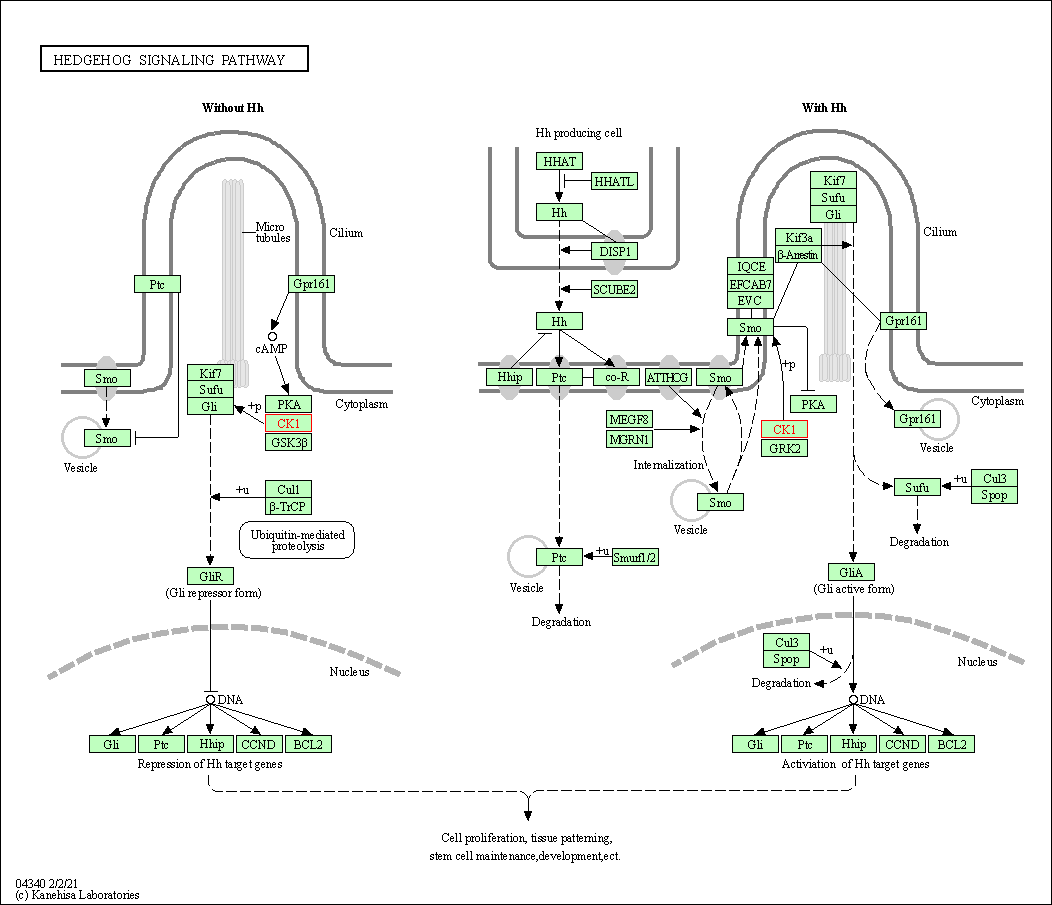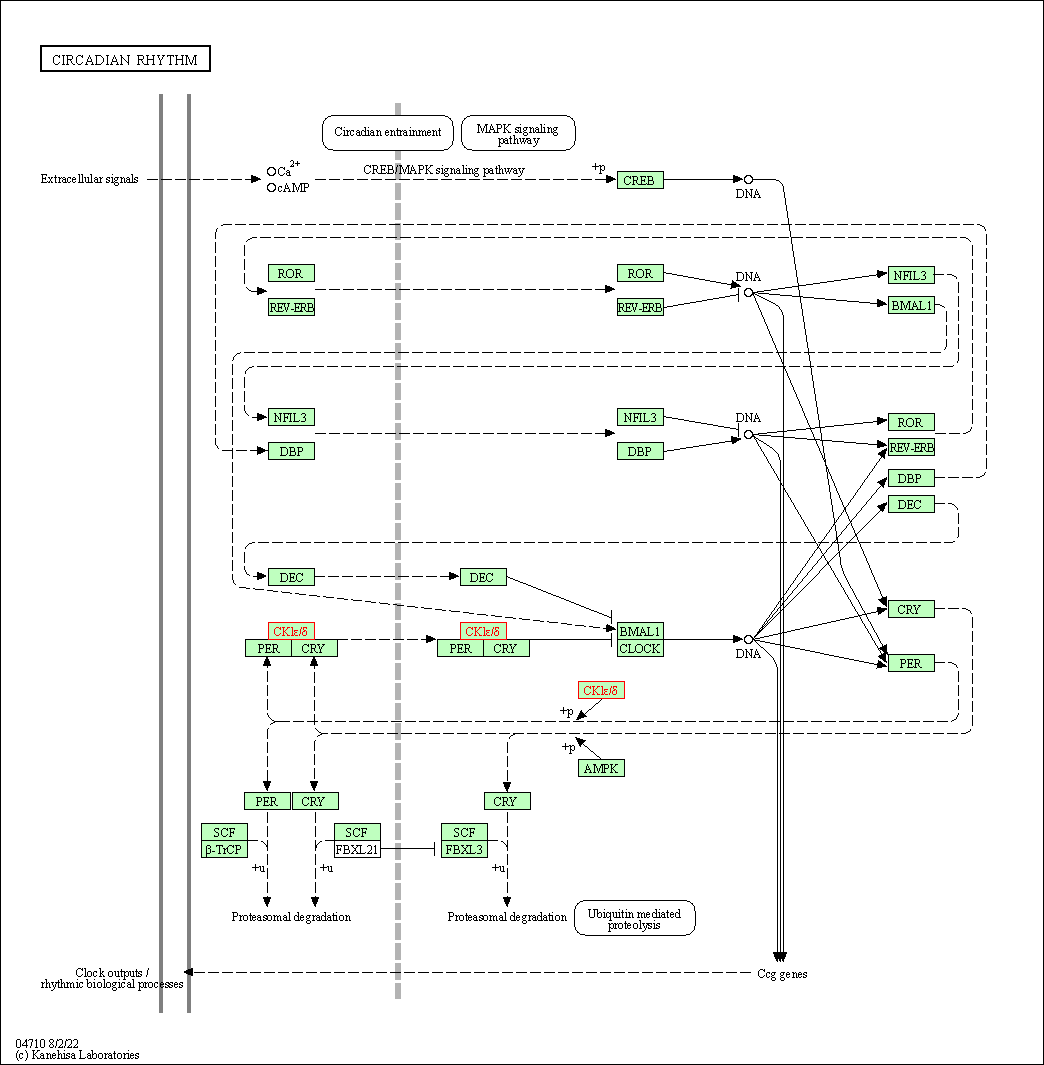Target Information
| Target General Information | Top | |||||
|---|---|---|---|---|---|---|
| Target ID |
T87109
(Former ID: TTDI03080)
|
|||||
| Target Name |
Casein kinase I delta (CSNK1D)
|
|||||
| Synonyms |
Tau-protein kinase CSNK1D; HCKID; Casein kinase I isoform delta; CKId; CKI-delta
Click to Show/Hide
|
|||||
| Gene Name |
CSNK1D
|
|||||
| Target Type |
Preclinical target
|
[1] | ||||
| Disease | [+] 2 Target-related Diseases | + | ||||
| 1 | Mature B-cell leukaemia [ICD-11: 2A82] | |||||
| 2 | Pancreatic cancer [ICD-11: 2C10] | |||||
| Function |
It can phosphorylate a large number of proteins. Casein kinases are operationally defined by their preferential utilization of acidic proteins such as caseins as substrates. Phosphorylates connexin-43/GJA1, MAP1A, SNAPIN, MAPT/TAU, TOP2A, DCK, HIF1A, EIF6, p53/TP53, DVL2, DVL3, ESR1, AIB1/NCOA3, DNMT1, PKD2, YAP1, PER1 and PER2. Central component of the circadian clock. In balance with PP1, determines the circadian period length through the regulation of the speed and rhythmicity of PER1 and PER2 phosphorylation. Controls PER1 and PER2 nuclear transport and degradation. YAP1 phosphorylation promotes its SCF(beta-TRCP) E3 ubiquitin ligase-mediated ubiquitination and subsequent degradation. DNMT1 phosphorylation reduces its DNA-binding activity. Phosphorylation of ESR1 and AIB1/NCOA3 stimulates their activity and coactivation. Phosphorylation of DVL2 and DVL3 regulates WNT3A signaling pathway that controls neurite outgrowth. EIF6 phosphorylation promotes its nuclear export. Triggers down-regulation of dopamine receptors in the forebrain. Activates DCK in vitro by phosphorylation. TOP2A phosphorylation favors DNA cleavable complex formation. May regulate the formation of the mitotic spindle apparatus in extravillous trophoblast. Modulates connexin-43/GJA1 gap junction assembly by phosphorylation. Probably involved in lymphocyte physiology. Regulates fast synaptic transmission mediated by glutamate. Essential serine/threonine-protein kinase that regulates diverse cellular growth and survival processes including Wnt signaling, DNA repair and circadian rhythms.
Click to Show/Hide
|
|||||
| BioChemical Class |
Kinase
|
|||||
| UniProt ID | ||||||
| EC Number |
EC 2.7.11.1
|
|||||
| Sequence |
MELRVGNRYRLGRKIGSGSFGDIYLGTDIAAGEEVAIKLECVKTKHPQLHIESKIYKMMQ
GGVGIPTIRWCGAEGDYNVMVMELLGPSLEDLFNFCSRKFSLKTVLLLADQMISRIEYIH SKNFIHRDVKPDNFLMGLGKKGNLVYIIDFGLAKKYRDARTHQHIPYRENKNLTGTARYA SINTHLGIEQSRRDDLESLGYVLMYFNLGSLPWQGLKAATKRQKYERISEKKMSTPIEVL CKGYPSEFATYLNFCRSLRFDDKPDYSYLRQLFRNLFHRQGFSYDYVFDWNMLKFGASRA ADDAERERRDREERLRHSRNPATRGLPSTASGRLRGTQEVAPPTPLTPTSHTANTSPRPV SGMERERKVSMRLHRGAPVNISSSDLTGRQDTSRMSTSQIPGRVASSGLQSVVHR Click to Show/Hide
|
|||||
| 3D Structure | Click to Show 3D Structure of This Target | PDB | ||||
| Drugs and Modes of Action | Top | |||||
|---|---|---|---|---|---|---|
| Preclinical Drug(s) | [+] 2 Preclinical Drugs | + | ||||
| 1 | D-4476 | Drug Info | Preclinical | Chronic lymphocytic leukaemia | [2] | |
| 2 | PF-4800567 | Drug Info | Preclinical | Chronic lymphocytic leukaemia | [2] | |
| Mode of Action | [+] 1 Modes of Action | + | ||||
| Inhibitor | [+] 3 Inhibitor drugs | + | ||||
| 1 | D-4476 | Drug Info | [4] | |||
| 2 | PF-4800567 | Drug Info | [5] | |||
| 3 | PMID24900428C14 | Drug Info | [6] | |||
| Cell-based Target Expression Variations | Top | |||||
|---|---|---|---|---|---|---|
| Cell-based Target Expression Variations | ||||||
| Drug Binding Sites of Target | Top | |||||
|---|---|---|---|---|---|---|
| Ligand Name: Adenosine monophosphate | Ligand Info | |||||
| Structure Description | Crystal structure of phosphorylated pT220 Casein Kinase I delta (CK1d), conformation 2 and 3 | PDB:7P7G | ||||
| Method | X-ray diffraction | Resolution | 1.70 Å | Mutation | No | [7] |
| PDB Sequence |
RYRLGRKIGS
17 GSFGDIYLGT27 DIAAGEEVAI37 KLECVKTKHP47 QLHIESKIYK57 MMQGGVGIPT 67 IRWCGAEGDY77 NVMVMELLGP87 SLEDLFNFCS97 RKFSLKTVLL107 LADQMISRIE 117 YIHSKNFIHR127 DVKPDNFLMG137 LGKKGNLVYI147 IDFGLAKKYR157 DARTHQHIPY 167 RENKNLTGTA177 RYASINTHLG187 IEQSRRDDLE197 SLGYVLMYFN207 LGSLPWQGLK 217 AAKRQKYERI228 SEKKMSTPIE238 VLCKGYPSEF248 ATYLNFCRSL258 RFDDKPDYSY 268 LRQLFRNLFH278 RQGFSYDYVF288 DWNMLK
|
|||||
|
|
||||||
| Click to View More Binding Site Information of This Target and Ligand Pair | ||||||
| Ligand Name: PF-4800567 | Ligand Info | |||||
| Structure Description | Crystal structure of ck1d in complex with pf4800567 | PDB:4HNF | ||||
| Method | X-ray diffraction | Resolution | 2.07 Å | Mutation | No | [8] |
| PDB Sequence |
LRVGNRYRLG
12 RKIGSGSFGD22 IYLGTDIAAG32 EEVAIKLECV42 KPQLHIESKI55 YKMMQGGVGI 65 PTIRWCGAEG75 DYNVMVMELL85 GPSLEDLFNF95 CSRKFSLKTV105 LLLADQMISR 115 IEYIHSKNFI125 HRDVKPDNFL135 MGLGKKGNLV145 YIIDFGLAKK155 YRDARTHQHI 165 PYRENKNLTG175 TARYASINTH185 LGIEQSRRDD195 LESLGYVLMY205 FNLGSLPWQG 215 LKAATKRQKY225 ERISEKKMST235 PIEVLCKGYP245 SEFATYLNFC255 RSLRFDDKPD 265 YSYLRQLFRN275 LFHRQGFSYD285 YVFDWNMLK
|
|||||
|
|
||||||
| Click to View More Binding Site Information of This Target with Different Ligands | ||||||
| Different Human System Profiles of Target | Top |
|---|---|
|
Human Similarity Proteins
of target is determined by comparing the sequence similarity of all human proteins with the target based on BLAST. The similarity proteins for a target are defined as the proteins with E-value < 0.005 and outside the protein families of the target.
A target that has fewer human similarity proteins outside its family is commonly regarded to possess a greater capacity to avoid undesired interactions and thus increase the possibility of finding successful drugs
(Brief Bioinform, 21: 649-662, 2020).
Human Tissue Distribution
of target is determined from a proteomics study that quantified more than 12,000 genes across 32 normal human tissues. Tissue Specificity (TS) score was used to define the enrichment of target across tissues.
The distribution of targets among different tissues or organs need to be taken into consideration when assessing the target druggability, as it is generally accepted that the wider the target distribution, the greater the concern over potential adverse effects
(Nat Rev Drug Discov, 20: 64-81, 2021).
Human Pathway Affiliation
of target is determined by the life-essential pathways provided on KEGG database. The target-affiliated pathways were defined based on the following two criteria (a) the pathways of the studied target should be life-essential for both healthy individuals and patients, and (b) the studied target should occupy an upstream position in the pathways and therefore had the ability to regulate biological function.
Targets involved in a fewer pathways have greater likelihood to be successfully developed, while those associated with more human pathways increase the chance of undesirable interferences with other human processes
(Pharmacol Rev, 58: 259-279, 2006).
Biological Network Descriptors
of target is determined based on a human protein-protein interactions (PPI) network consisting of 9,309 proteins and 52,713 PPIs, which were with a high confidence score of ≥ 0.95 collected from STRING database.
The network properties of targets based on protein-protein interactions (PPIs) have been widely adopted for the assessment of target’s druggability. Proteins with high node degree tend to have a high impact on network function through multiple interactions, while proteins with high betweenness centrality are regarded to be central for communication in interaction networks and regulate the flow of signaling information
(Front Pharmacol, 9, 1245, 2018;
Curr Opin Struct Biol. 44:134-142, 2017).
Human Similarity Proteins
Human Tissue Distribution
Human Pathway Affiliation
Biological Network Descriptors
|
|
|
Note:
If a protein has TS (tissue specficity) scores at least in one tissue >= 2.5, this protein is called tissue-enriched (including tissue-enriched-but-not-specific and tissue-specific). In the plots, the vertical lines are at thresholds 2.5 and 4.
|
| KEGG Pathway | Pathway ID | Affiliated Target | Pathway Map |
|---|---|---|---|
| Hedgehog signaling pathway | hsa04340 | Affiliated Target |

|
| Class: Environmental Information Processing => Signal transduction | Pathway Hierarchy | ||
| Hippo signaling pathway | hsa04390 | Affiliated Target |

|
| Class: Environmental Information Processing => Signal transduction | Pathway Hierarchy | ||
| Gap junction | hsa04540 | Affiliated Target |

|
| Class: Cellular Processes => Cellular community - eukaryotes | Pathway Hierarchy | ||
| Circadian rhythm | hsa04710 | Affiliated Target |

|
| Class: Organismal Systems => Environmental adaptation | Pathway Hierarchy | ||
| Degree | 14 | Degree centrality | 1.50E-03 | Betweenness centrality | 7.95E-04 |
|---|---|---|---|---|---|
| Closeness centrality | 2.47E-01 | Radiality | 1.43E+01 | Clustering coefficient | 2.53E-01 |
| Neighborhood connectivity | 5.86E+01 | Topological coefficient | 9.83E-02 | Eccentricity | 11 |
| Download | Click to Download the Full PPI Network of This Target | ||||
| Chemical Structure based Activity Landscape of Target | Top |
|---|---|
| Drug Property Profile of Target | Top | |
|---|---|---|
| (1) Molecular Weight (mw) based Drug Clustering | (2) Octanol/Water Partition Coefficient (xlogp) based Drug Clustering | |
|
|
||
| (3) Hydrogen Bond Donor Count (hbonddonor) based Drug Clustering | (4) Hydrogen Bond Acceptor Count (hbondacc) based Drug Clustering | |
|
|
||
| (5) Rotatable Bond Count (rotbonds) based Drug Clustering | (6) Topological Polar Surface Area (polararea) based Drug Clustering | |
|
|
||
| "RO5" indicates the cutoff set by lipinski's rule of five; "D123AB" colored in GREEN denotes the no violation of any cutoff in lipinski's rule of five; "D123AB" colored in PURPLE refers to the violation of only one cutoff in lipinski's rule of five; "D123AB" colored in BLACK represents the violation of more than one cutoffs in lipinski's rule of five | ||
| Target Poor or Non Binders | Top | |||||
|---|---|---|---|---|---|---|
| Target Poor or Non Binders | ||||||
| Target Regulators | Top | |||||
|---|---|---|---|---|---|---|
| Target-interacting Proteins | ||||||
| References | Top | |||||
|---|---|---|---|---|---|---|
| REF 1 | Crystal structure of a conformation-selective casein kinase-1 inhibitor. J Biol Chem. 2000 Jun 30;275(26):20052-60. | |||||
| REF 2 | Circadian rhythm as a therapeutic target. Nat Rev Drug Discov. 2021 Apr;20(4):287-307. | |||||
| REF 3 | Casein kinase 1 is a therapeutic target in chronic lymphocytic leukemia. Blood. 2018 Mar 15;131(11):1206-1218. | |||||
| REF 4 | The selectivity of protein kinase inhibitors: a further update. Biochem J. 2007 Dec 15;408(3):297-315. | |||||
| REF 5 | Selective inhibition of casein kinase 1 epsilon minimally alters circadian clock period. J Pharmacol Exp Ther. 2009 Aug;330(2):430-9. | |||||
| REF 6 | Structure-Based Design of Potent and Selective CK1gamma Inhibitors. ACS Med Chem Lett. 2012 Oct 18;3(12):1059-64. | |||||
| REF 7 | Kinase domain autophosphorylation rewires the activity and substrate specificity of CK1 enzymes. Mol Cell. 2022 Jun 2;82(11):2006-2020.e8. | |||||
| REF 8 | Structural basis for the potent and selective inhibition of casein kinase 1 epsilon. J Med Chem. 2012 Nov 26;55(22):10307-11. | |||||
If You Find Any Error in Data or Bug in Web Service, Please Kindly Report It to Dr. Zhou and Dr. Zhang.

